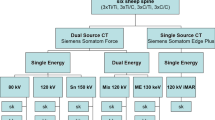Abstract
Objective
As cancer treatments continue to improve, the incidence of spinal metastases and the need for surgical management of these with fixation procedures are growing rapidly. Traditionally metallic implants, composed of titanium alloy, have been used in surgical fixation of unstable or symptomatic vertebral metastases or traumatic injuries. Metallic implants, however, cause significant artifact on post-operative imaging, degrading image quality and limiting interpretation, and can also impair the planning and delivery of radiotherapy. Composite carbon fiber–based materials, such as carbon fiber–reinforced polyetheretherketone (PEEK), have been developed to overcome these issues and are now available for spinal fixation procedures. We aimed to review the multimodal imaging features of these new implants.
Materials and methods
Current literature and a case example from our institution were used to describe the multimodal imaging characteristics and considerations of new carbon fiber-based spinal fixation implants.
Results
New carbon fiber-based spinal implants allow far greater visualization of surrounding structures on post-operative cross-sectional imaging, significantly improving diagnostic accuracy and precision of radiotherapy planning, and do not significantly absorb or scatter X-ray photons during radiotherapy delivery. There are, however, important surgical and radiologic considerations associated with the use of carbon fiber-based implants which radiologists must be aware of, such as implications for surgical planning and intra-operative fluoroscopic and post-operative plain radiographic imaging.
Conclusion
The use of carbon fiber-based implants, rather than traditional metallic implants, for spinal fixation offers significant advantages for post-operative diagnostic imaging and radiotherapy planning and delivery.







Similar content being viewed by others
References
Sutcliffe P, Connock M, Shyangdan D, Court R, Kandala NB, Clarke A. A systematic review of evidence on malignant spinal metastasis: natural history and technologies for identifying patients at high risk of vertebral fracture and spinal cord compression. Health Technol Assess. 2013;17:1–274. https://doi.org/10.3310/hta17420.
Sciubba DM, Petteys RJ, Dekutoski MB, et al. Diagnosis and management of metastatic spine disease. J Neurosurg Spine. 2010;13:94–108. https://doi.org/10.3171/2010.3.SPINE09202.
Laux CJ, Hodel SM, Farshad M, Muller DA. Carbon fiber/polyether ether ketone (PEEK) implants in orthopaedic oncology. World J Surg Oncol. 2018;16:241. https://doi.org/10.1186/s12957-018-1545-9.
Tedesco G, Gasbarrini A, Bandiera S, Ghermandi R, Boriani S. Composite PEEK/carbon fiber implants can increase the effectiveness of radiotherapy in the management of spine tumors. J Spine Surg. 2017;3:323–9. https://doi.org/10.21037/jss.2017.06.20.
Rutz HP, Weber DC, Sugahara S, et al. Extracranial chordoma: outcome in patients treated with function-preserving surgery followed by spot-scanning proton beam irradiation. Int J Radiat Oncol Biol Phys. 2007;67:512–20. https://doi.org/10.1016/j.ijrobp.2006.08.052.
Seaman S, Kerezoudis P, Bydon M, Torner JC, Hitchon PW. Titanium vs. polyetheretherketone (PEEK) interbody fusion: meta-analysis and review of the literature. J Clin Neurosci. 2017;44:23–9. https://doi.org/10.1016/j.jocn.2017.06.062.
Steinberg EL, Rath E, Shlaifer A, Chechik O, Maman E, Salai M. Carbon fiber reinforced PEEK Optima—a composite material biomechanical properties and wear/debris characteristics of CFPEEK composites for orthopedic trauma implants. J Mech Behav Biomed Mater. 2013;17:221–8. https://doi.org/10.1016/j.jmbbm.2012.09.013.
Tarallo L, Mugnai R, Adani R, Zambianchi F, Catani F. A new volar plate made of carbon-fiberreinforced polyetheretherketon for distal radius fracture: analysis of 40 cases. J Orthop Trauma. 2014;15:277–83. https://doi.org/10.1007/s10195-014-0311-1.
Bruner HJ, Guan Y, Yoganandan N, Pintar FA, Maiman DJ, Slivka MA. Biomechanics of polyaryletherketone rod composites and titanium rods for posterior lumbosacral instrumentation. Presented at the 2010 Joint Spine Section Meeting. Laboratory investigation. J Neurosurg Spine. 2010;13:766–72. https://doi.org/10.3171/2010.5.SPINE09948.
Ringel F, Ryang YM, Kirschke JS, et al. Radiolucent carbon fiber-reinforced pedicle screws for treatment of spinal tumours: advantages for radiation planning and follow-up imaging. World Neurosurg. 2017;105:294–301. https://doi.org/10.1016/j.wneu.2017.04.091.
White LM, Buckwalter KA. Technical considerations: CT and MR imaging in the postoperative orthopedic patient. Semin Musculoskelet Radiol. 2002;6:5–17. https://doi.org/10.1055/s-2002-23160.
Zimel MN, Hwang S, Riedel ER, Healey JH. Carbon fiber intramedullary nails reduce artifact in postoperative advanced imaging. Skelet Radiol. 2015;44:1317–25. https://doi.org/10.1007/s00256-015-2158-9.
Hargreaves BA, Worters PW, Pauly KB, Pauly JM, Koch KM, Gold GE. Metal-induced artifacts in MRI. AJR Am J Roentgenol. 2011;197:547–55. https://doi.org/10.2214/AJR.11.7364.
Triche BL, Nelson JT Jr, McGill NS, et al. Recognizing and minimizing artifacts at CT, MRI, US, and molecular imaging. Radiographics. 2019;39:1017–8. https://doi.org/10.1148/rg.2019180022.
Uri O, Folman Y, Laufer G, Behrbalk E. A novel spine fixation system made entirely of carbon-fiber-reinforced PEEK composite: an in vitro mechanical evaluation. Adv Orthop. 2020;4796136. https://doi.org/10.1155/2020/4796136.
Boriani S, Tedesco G, Ling L, et al. Carbon-fiber-reinforced PEEK fixation system in the treatment of spine tumours: a preliminary report. Eur Spine J. 2018;27:874–81. https://doi.org/10.1007/s00586-017-5258-5.
Nasser R, Yadla S, Maltenfort MG, et al. Complications in spine surgery. J Neurosurg Spine. 2010;13:144–57. https://doi.org/10.3171/2010.3.SPINE09369.
Cofana F, Di Perna G, Monticella M, et al. Carbon fiber reinforced vs titanium implants for fixation in spinal metastasis: a comparative clinical study about safety and effectiveness of the new “carbon-strategy”. J Clin Neurosci. 2020;75:106–11. https://doi.org/10.1016/j.jocn.2020.03.013.
Author information
Authors and Affiliations
Corresponding author
Ethics declarations
Conflict of interest
The authors declare that they have no conflict of interest
Ethical approval
All procedures performed in studies involving human participants were in accordance with the ethical standards of the institutional and/or national research committee and with the 1964 Helsinki declaration and its later amendments or comparable ethical standards.
Informed consent
Informed consent was obtained from all individual participants included in the study.
Additional information
Publisher’s note
Springer Nature remains neutral with regard to jurisdictional claims in published maps and institutional affiliations.
Rights and permissions
About this article
Cite this article
Delaney, F.T., Denton, H., Dodds, M. et al. Multimodal imaging of composite carbon fiber–based implants for orthopedic spinal fixation. Skeletal Radiol 50, 1039–1045 (2021). https://doi.org/10.1007/s00256-020-03622-6
Received:
Revised:
Accepted:
Published:
Issue Date:
DOI: https://doi.org/10.1007/s00256-020-03622-6




